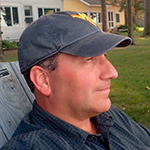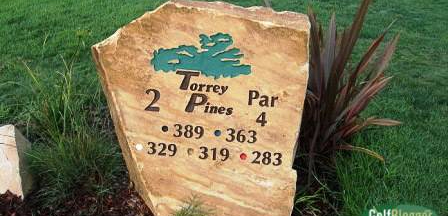To understand why golf takes so long to play (and, not coincidentally, why scores are so high), look no further than the tee box.
My unscientific but closely observed conclusion is that most golfers are playing from the wrong tees. Playing from the back tees might be manly (and let us be clear that 100% of the offenders are men), but makes little sense for most.
Consider:
The average drive of the average male golfer is 192 yards (according to the USGA and major manufacturers). That same golfer, however, thinks that he hits the ball 230 yards on average.
Only one in 50 golfers routinely hits drives of 250 yards or more.
The average female golfer hits a drive of 135 yards. Seniors on average are able to drive 180 yards.
All golfers, in fact, consistently overestimate the length of their shots—both on drives and from the fairway.
The average score for a round of golf remains at 100—where it has been for many decades. Just 22% of golfers manage to break 90 on a regular basis. Only 5% manage to break 80.
The average handicap for a man is 16.1. The average handicap for a woman is 28. And considering that it’s only the most dedicated golfers that bother to keep an official handicap, the handicap for the general population is likely much higher
Less than 1 percent of the golfing population plays to a low single digit handicap.
Here’s why these numbers matter to playing time: Playing from the back tees is likely to add at least one shot on every hole on the course. On a par 4, a drive that falls short of the legitimate range of short- to mid- irons (wedge to seven) drastically reduces the chance of hitting the green in regulation. A weekend player may have the length to cover the distance in two, but with a long iron or wood for the second, chances are he won’t hit the green. The weekender thus takes an an extra shot or two trying to get up from a greenside bunker or grass.
If a player does manage to hit and hold the green with one of those long irons or woods, chances are that it is not going to be in birdie range. Why do pro golfers make so many birdies when compared to amateurs? Proximity to the hole on the approach shots. The pros, with their short-iron approaches are in birdie range. Amateurs, hitting in with longer irons are setting themselves up for a two-or-three putt.
Further, if forced to hit driver on every hole to get the distance required, weekenders also increase the chance of landing in the rough, in the trees, or worse. In that case, even if the ball does fly 250 yards, a shot is added getting out of trouble. On a par 5, golfers not only face this risk on the tee shot, but also on the second, where the necessity of playing a long club to get into scoring range presents a second opportunity to get into trouble.
Then there’s the lost ball issue. When forced to constantly hit the big sticks, balls will be lost. And time will be lost looking for them.
All of those shots add up. Assume three minutes for each shot per player (travel time, locating the ball, picking a club practice swings, watching the ball flight, putting the club away, etc.). Multiply that by 14 extra shots per round per player (and likely more, but I’ll be conservative) and each player loses 42 minutes to poor tee selection; for the group, that adds up to 168 minutes. Even with some overlap (two players preparing at the same time), and holes where players don’t actually take the extra shot, that adds an hour-and-a-half to two hours to a round.
Poor tee selection thus explains the five-to-six-hour round very neatly. It also explains the high scores.
The distance problem bleeds over into other aspects of the game. Realizing (at least subconsciously) that near perfect shots are required to compete against the too-long course, players start taking extra practice swings and more time to line up shots. Then, once on the green, they agonize over the thirty foot putt that will save their double-bogey.
Identifying the problem is, however, easier than solving it.
One solution requires players to have a realistic understanding of how far they hit their clubs. This is more difficult than it sounds. Remember that most male golfers average 192 off the tee, but think they hit it 230. Pros will tell you that one of the biggest problems they see with their pro-am partners is not taking enough club. That’s because, even with mid- and short-irons, amateurs have unrealistic distance expectations.
One rule of thumb for distance is to play from the tees that offer a decent chance at using a mid or short iron on the par 4s. If a typical driver shot is 200 yards, and a player’s six iron goes 150, then on a par 4, the player should use the tees that are closest to 350 from the green. Anything longer will require the rare heroic shot.
Another way to assess the proper course length is to use the Rule of 28, as described by Chris Mile, owner of the Miles of Golf pro shop in Ypsilanti, Michigan. Mile says that to find the proper tees, you should multiply your average driving distance by 28. Play the tees whose yardage is closest to this product. This means that the average player who hits the ball 200 yards on a drive should play from the tees closest to 5,600 yards.
Paige Mackenzie on The Golf Channel’s Morning Drive recently offered a different formula to determine a player’s proper yardage.
(Distance for 7 Iron x 18) + (Average Driving Distance x 14) = Yardage To Play
Under this formula, a player who hits a 130 yard 7 iron (typical) and a 200-yard drive should play (2, 340) + (3,600) = 5, 940.
My guess that either of those two figures is three to five hundred yards shorter than the yardage typically played.
Even armed with this knowledge, it will be difficult to convince players to move up a tee or two. Far too many seem to believe that playing a course from a shorter distance is either not allowed, not fun, or simply unmanly.
It would help if the golf media stopped glorifying the most difficult courses. Recently, while leading up to to the PGA Tour event at Bethpage Black, the Golf Channel spent two hours of Morning Drive talking about the toughest courses in America. Matt Ginella crowed that at Kiawah Island, you’ll have to go into the clubhouse for more balls at the turn. Distance and difficulty are touted by golf media as measures of a course’s greatness.
If you have to go back to the clubhouse for more balls at the turn, chances are you’re playing from the wrong tees. It also is very likely that you’re on your way to a six-hour round.
The sort of mind-set encouraged by the mainstream golf media is not at all helpful for the continued health of the game. Weekenders go to courses thinking that if they are not playing from the tips, they are not enjoying the game. They then get frustrated and, thinking they will never be good enough, stop playing.
The PGA, USGA, state golf associations and local courses need to revive and double down on the “Play It Forward” movement of a couple of years ago. Players need to be convinced that they are missing out on a lot of fun by playing from the tips. Ninety-nine-point-nine percent of us are not practicing for the US Open. It’s simply a lot more fun to hit driver-eight iron-putt-putt than driver-long iron-wedge-chip-putt-putt on every hole. (and that’s assuming that your second shot isn’t a chip out of the woods).
When watching professional events on television, weekenders should pay attention to the clubs the professionals are using, not the distances they cover. Pro golfers will hit a three wood or hybrid and a short iron on a par four. Shouldn’t amateur golfers do the same?
On the course management side, there are a number of solutions.
One is to help players choose realistic tees. A number of courses I have visited identify tees on the cards by average score. That is, if you typically shoot in the 90s, the card indicates that you should play the green tees; if you shoot in the low 80s, play the whites, and so on.
A sign near the first tee, equating average scores to tees should be a feature on every course. With apologies to the USGA, courses need to use scores, not handicaps. Weekenders know their average score; few carry a realistic handicap.
Another solution is for courses to simply move the existing tees up during the busiest hours. That will shorten the course and allow players to finish in a decent amount of time. A small minority of golfers might miss the distance, but since the average golfer hits the ball just 192 off the tee, the vast majority will not.
Using non-traditional tee colors also might help. Thanks to misplaced machismo and some silly traditions, no adult male wants to play the red tees. But perception might change if the forward tees were green, the middle were yellow, and the backs were red. Or maybe the realistic tees for the men need to be the “camo” tees. Put a Budweiser label on the realistic tees.
Courses also can offer more tees. Staking out additional teeing areas allows players to move a little forward without going all the way to the “ladies tees.” Every little bit helps. A little deception might also be in order here. Placing a set of “super forward” tees (that almost no one would use) would give players permission to move up to a more realistic yardage while still keeping their distance from the “easy tees.”
If there is no room for additional tees, courses could try “hybrid tees.” Several courses I have played have “imaginary” tees on the scorecard for in-between yardages. For example, if a player is playing the “purple tees” at 6, 000 yards, the card indicates to play holes 1 and 2 from the existing blue tees, then to move up to the red tees on hole 3. For hole 4, the card indicates that the player should move back to the blues. The imaginary tees have their own course and slope ratings, just like physical tees. With this setup, players are not forced to make a choice between “too long” and “not long enough.” A course with three regular tee sets could create two to three more sets of tees with this system.
Play it forward. Take less time. Shoot lower scores. Have more fun.
Follow John on Twitter @golfbloggercom
 John Lloyd Retzer is the editor/writer/photographer/programmer/janitor of GolfBlogger.Com, the ‘net’s oldest continuously published golf blog. In his career, Retzer has worked as a teacher, lecturer, writer, ghost-writer, reporter, photographer, and recreation manager. Retzer has written three books, “The Five Inch Course: Thinking Your Way To Better Golf“, “Golf Remixed: New Ways To Play The Ancient Game” and “Things In The Basement: A History of Halloween Horrors.” He is a graduate of West Virginia University and the University of Michigan.
John Lloyd Retzer is the editor/writer/photographer/programmer/janitor of GolfBlogger.Com, the ‘net’s oldest continuously published golf blog. In his career, Retzer has worked as a teacher, lecturer, writer, ghost-writer, reporter, photographer, and recreation manager. Retzer has written three books, “The Five Inch Course: Thinking Your Way To Better Golf“, “Golf Remixed: New Ways To Play The Ancient Game” and “Things In The Basement: A History of Halloween Horrors.” He is a graduate of West Virginia University and the University of Michigan.
Back to #GolfChat Authors
